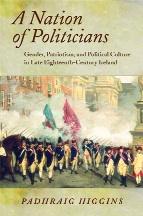A nation of politicians: gender, patriotism and political culture in late eighteenth-century Ireland
Published in 18th–19th - Century History, Issue 2(March/April 2012), Reviews, Volume 20
A nation of politicians: gender, patriotism and political culture in late eighteenth-century Ireland
Padhraig Higgins
(University of Wisconsin Press, $29.95)
ISBN 9780299233341
Francis Wheatley’s painting of the Volunteers commemorating King William’s birthday at College Green (4 November 1779), drawing readers to reach for this engaging book, has become the iconic depiction of Ireland’s ‘golden age’ of patriotism. Mirroring the harmonious lines of the Georgian streetscape forming its backdrop, this pictorial narrative of Protestant commemoration fused with a new, distinctly Irish patriotic identity accords equal space to the ordered, manly soldiery and the approving crowds gazing down from windows and rooftops through billows of smoke. We spot many well-dressed females, who readily participated in the new, very public, spheres of patriotism shaped by Volunteering, and not only by ‘shopping for Ireland’. Newspapers published elaborate details of the splendid uniforms and relayed the ambiance of drums beating, flags flying and volleys firing. Yet to scholars of the period, Wheatley’s view is too unthreatening and sanitised, having airbrushed out of history the bold sloganeering decking the statue’s pedestal. By 1779 the Volunteers, an independent paramilitary force and initially only ‘self-appointed as defenders of the nation’ against the threat of French invasion, had overtaken the theatre of politics, championing the cause of Irish commerce and even constitutional grievances. They had occupied Dame Street not only to parade their Protestant loyalism but also to demand the lifting of trade restrictions. A contemporary print (p. 95) humorously depicts a humble but respectable ‘Paddy’ on a quayside laden with Irish goods waiting to be exported: his shillelagh points to a cannon spurting a speech bubble, which verbalises the threat of ‘A free trade, OR ELSE!!!’. This ground-breaking book thoroughly examines the experience of political culture during this rage militaire, which gripped Ireland from 1779 to 1784, when the American War of Independence plunged Britain into imperial crisis. Not a linear-chronological narrative of the Volunteers, it fills a considerable gap in our understanding of the processes of politicisation that they engendered and various societal implications. Higgins adopts an innovative approach that reflects the cultural turn in history and also addresses gender identity, employing imaginative, if often densely worded, language. A rich teaching resource, this book will eruditely expose undergraduates to concepts such as ‘alehouse politicians’ and ‘petticoat government’, breathing life into the past while challenging them to pursue further research by delving into the predictable but varied sources informing Higgins’s discussion. Students may now critically engage with statements such as: ‘Volunteering did not . . . supplant traditional recreations associated with manliness, as evidenced by the drinking culture that characterised Volunteer sociability’ (p. 161).Reflecting vibrant new scholarship on Irish print culture and reading rituals, Higgins evidently stresses how important the tavern, coffee house and print shop were as sites of sociability. As an obvious vehicle of politicisation, the press included cheaper (in both price and taste) ways of communicating messages, such as cartoons, ballads and the elusive window transparencies that one would wish to see examples of. The military camp (referenced in many sadly neglected contemporary plays), review and communal meals led to greater social mixing and became a venue for political exchange. Patriotism was expressed through new forms of merchandising, enticing consumers of both genders to exercise civic virtue by favouring Irish textiles, ale and domestic objects displaying a national message. Imbibing rituals became a civic affair by emptying jugs (or teapots) decorated with Hibernia, the allegorical female embodiment of the nation, protected by an upright Volunteer. This book explores Ireland’s iconography in popular culture but never loses sight of the militarised masculinity of the Enlightenment. A tray (p. 102) depicts a neo-classical Hibernia resting on a harp: before her feet kneels a noble Volunteer, hand on heart, handing her a free trade bill. Though confined to its Irish context, this book echoes the recent emphasis in French studies on the ‘martialisation’ of the public imagination through ritual, culture and popular celebration. Higgins’s is a welcome contribution to a wider scholarship on the roots of the citizen-soldier, a concept too readily associated with the French Revolution. Though never mobilised in battle, the nationalist slogans, mottoes and military insignia gracing the flags and medals of the Irish Volunteers typify how warfare was becoming increasingly ideological, combatants serving a cause rather than a dynasty.Civic virtue by no means precluded overtly ‘playing the man’, and Volunteers famously indulged in the pleasure of parading in their elaborate (and self-financed) uniforms, recorded in many a specially commissioned portrait. This sartorial display of militarised patriotism enhanced sexual allure and was symptomatic of the increased consumption of the age. Female fashion also appropriated details emulating uniforms. In Wheatley’s painting of the Irish House of Commons, the wives of Volunteer officers crowding the best seats of the gallery wear a feminised version of the bright red garbe militaire that Henry Grattan is sporting below, as he argues for legislative independence. Appropriately, the book concludes by partially addressing how ‘democratical’ the spirit of this new imagined community truly was, given that its Catholic majority, forbidden in theory from bearing arms, could not display its loyalty. If by 1786 the Volunteers were a spent force that had not brought about reform, their legacy was linked to the rapid and radical transformation of patriotic politics, reworked by the United Irishmen in the 1790s and feeding the romantic historicism of the 1840s. The book always contextualises events, but favours the encounters of ordinary people with patriotic symbols over high politics. Even Daniel O’Connell sported ‘1782’ buttons. HI
Sylvie Kleinman is a research fellow at the Centre for War Studies, Trinity College, Dublin.
















